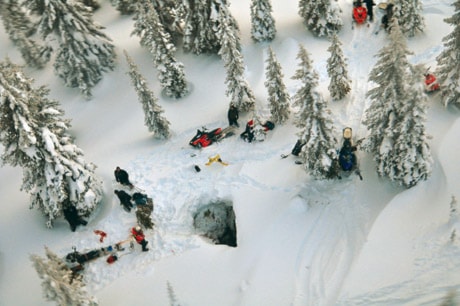NELSON, B.C. — A snowmobiler sledding through new-fallen, backcountry snow found himself plunging, tumbling and sliding 30 metres into an abandoned, mine shaft.
But seven hours after the sledder crested a hill to see the gaping hole too late to stop himself from being swallowed, Ken Gadicke was in an ambulance with only a few broken bones, thanks to his two sledding companions and a team of search and rescuers.
Scott Spencer with Nelson Search and Rescue coordinated the efforts Tuesday to retrieve the 58-year-old Nelson-area man.
“Many people that were there describe it as a miracle that he’s alive,” Spencer said.
Tuesday in the area was a beautiful, sunny day with fresh snow and the backcountry was filled with enthusiasts, including several members of Spencer’s team.
But this area of the Kootenay Pass between Nelson and Creston is pock-marked with hundreds of abandoned mine shafts, a fact well-known by those who use the area.
“The subject was coming around a corner and over a rise when he saw a hole too late to respond to avoid it,” Spencer said.
“He tried to gun his snowmobile to get out of the hole and that action bucked him off the snowmobile itself and the snowmobile was stuck either at the edge or a small ways into the hole.”
Spencer said the shaft is a complex series of vertical drops and steep slopes, so Gadicke didn’t fall 30 metres all at once. Instead, Spencer said he dropped for part of the way, landing on a steep slope to slide down further before then dropping again.
At 30 metres down, the sledder wasn’t near the end.
“By the descriptions of witnesses and our rescue teams, the shaft was riddled with holes that went off to different directions and dropped into deep shafts on either side supported by old timbers and logs,” Spencer said.
“So it was a fairly dangerous situation that he was in himself.”
Nelson Search and Rescue got the call about Gadicke at about 12:30 p.m. and Spencer began assembling a team.
But his members aren’t trained for mine rescue and experts from B.C. Cave Rescue wouldn’t be able to get there for hours.
He said initially, three members from his group flew over the site via helicopter, including a doctor trained in such rescues and an avalanche technician, who said the risk of an avalanche wasn’t huge.
But Spencer said Gadicke also owes the quick response to the two friends he was sledding with.
After the accident, one stayed with him while the other sledded back to the highway and managed to contact the B.C. Ambulance Service before returning to his friend.
As Spencer’s people were gathering, the two friends climbed into the hole, gave Gadicke some blankets and got a rope around the man.
“They proceeded to literally drag him out of the hole as best they could,” Spencer said.
“By all safety standards, it was the wrong thing to do. (It was) incredibly brave because going into mines at any time is a dangerous thing.”
Spencer noted mine shafts often lack oxygen and there is a potential for deadly gas to be present.
The friends managed to get the sledder to within about seven metres of the surface, making the rescue swift.
